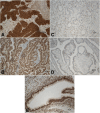Expression of zinc finger transcription factors (ZNF143 and ZNF281) in serous borderline ovarian tumors and low-grade ovarian cancers
- PMID: 30885238
- PMCID: PMC6423742
- DOI: 10.1186/s13048-019-0501-9
Expression of zinc finger transcription factors (ZNF143 and ZNF281) in serous borderline ovarian tumors and low-grade ovarian cancers
Abstract
Low-grade ovarian cancers represent up to 8% of all epithelial ovarian carcinomas (EOCs). Recent studies demonstrated that epithelial-mesenchymal transition (EMT) is crucial for the progression of EOCs. EMT plays a key role in cancer invasion, metastasis formation and chemotherapy resistance. An array of novel EMT transcription factors from the zinc finger protein family have been described recently, among them zinc finger protein 143 (ZNF143) and zinc finger protein 281 (ZNF281). The study included tissue specimens from 42 patients. Based on histopathological examination of surgical specimens, eight lesions were classified as serous borderline ovarian tumors (sBOTs) and 34 as low-grade EOCs. The proportions of the ovarian tumors that tested positively for ZNF143 and ZNF281 were 90 and 57%, respectively. No statistically significant differences were found in the expressions of ZNF143 and ZNF281 transcription factors in SBOTs and low-grade EOCs. Considering the expression patterns for ZNF143 and ZNF281 identified in this study, both sBOTs and low-grade EOCs might undergo a dynamic epithelial-mesenchymal interconversion. The lack of statistically significant differences in the expressions of the zinc finger proteins in sBOTs and low-grade serous EOCs might constitute an evidence for common origin of these two tumor types.
Keywords: Borderline ovarian tumor; Epithelial-mesenchymal transition; Low-grade ovarian cancer; Ovarian cancer; Transcription factors; ZNF143; ZNF281.
Conflict of interest statement
Ethics approval and consent to participate
The study conformed with the rules of Good Clinical Practice and its protocol was approved by the Local Bioethics Committee at Collegium Medicum, Nicolaus Copernicus University in Torun, and written informed consent was sought from each patient or her next of kin.
Consent for publication
Not applicable.
Competing interests
The authors declare that they have no competing interests.
Publisher’s Note
Springer Nature remains neutral with regard to jurisdictional claims in published maps and institutional affiliations.
Figures


Similar articles
-
Expression of selected epithelial-mesenchymal transition transcription factors in serous borderline ovarian tumors and type I ovarian cancers.Tumour Biol. 2018 Jun;40(6):1010428318784807. doi: 10.1177/1010428318784807. Tumour Biol. 2018. PMID: 29952249
-
Determination of BRAF V600E (VE1) protein expression and BRAF gene mutation status in codon 600 in borderline and low-grade ovarian cancers.Tumour Biol. 2017 May;39(5):1010428317706230. doi: 10.1177/1010428317706230. Tumour Biol. 2017. PMID: 28488545
-
Expression and prognostic significance of epithelial-mesenchymal transition-related markers and phenotype in serous ovarian cancer.Pathol Res Pract. 2018 Oct;214(10):1564-1571. doi: 10.1016/j.prp.2018.07.016. Epub 2018 Jul 25. Pathol Res Pract. 2018. PMID: 30082157
-
ZNF281/ZBP-99: a new player in epithelial-mesenchymal transition, stemness, and cancer.J Mol Med (Berl). 2014 Jun;92(6):571-81. doi: 10.1007/s00109-014-1160-3. Epub 2014 May 18. J Mol Med (Berl). 2014. PMID: 24838609 Review.
-
Principles of Treatment for Borderline, Micropapillary Serous, and Low-Grade Ovarian Cancer.J Natl Compr Canc Netw. 2016 Sep;14(9):1175-82. doi: 10.6004/jnccn.2016.0124. J Natl Compr Canc Netw. 2016. PMID: 27587627 Review.
Cited by
-
Expression of Selected Epithelial-Mesenchymal Transition Transcription Factors in Endometrial Cancer.Biomed Res Int. 2020 Dec 29;2020:4584250. doi: 10.1155/2020/4584250. eCollection 2020. Biomed Res Int. 2020. PMID: 33457409 Free PMC article.
-
Ovarian Cancer: Biomarkers and Targeted Therapy.Biomedicines. 2021 Jun 18;9(6):693. doi: 10.3390/biomedicines9060693. Biomedicines. 2021. PMID: 34207450 Free PMC article. Review.
-
Transcriptome Patterns of BRCA1- and BRCA2- Mutated Breast and Ovarian Cancers.Int J Mol Sci. 2021 Jan 28;22(3):1266. doi: 10.3390/ijms22031266. Int J Mol Sci. 2021. PMID: 33525353 Free PMC article.
-
BUB1B (BUB1 Mitotic Checkpoint Serine/Threonine Kinase B) promotes lung adenocarcinoma by interacting with Zinc Finger Protein ZNF143 and regulating glycolysis.Bioengineered. 2022 Feb;13(2):2471-2485. doi: 10.1080/21655979.2021.2013108. Bioengineered. 2022. PMID: 35068350 Free PMC article.
-
Advances in understanding the molecular mechanisms of borderline ovarian tumors.Front Mol Biosci. 2024 Aug 30;11:1429852. doi: 10.3389/fmolb.2024.1429852. eCollection 2024. Front Mol Biosci. 2024. PMID: 39281319 Free PMC article. Review.
References
-
- Bray F, Ferlay J, Soerjomataram I, Siegel RL, Torre LA, Jemal A Global Cancer statistics 2018: GLOBOCAN estimates of incidence and mortality worldwide for 36 cancers in 185 countries. CA Cancer J Clin, in press. The online GLOBOCAN 2018 database is accessible at http://gco.iarc.fr/, as part of IARC’s Global Cancer Observatory. - PubMed
Publication types
MeSH terms
Substances
LinkOut - more resources
Full Text Sources
Medical

